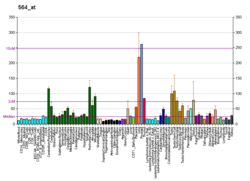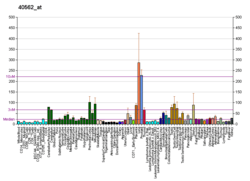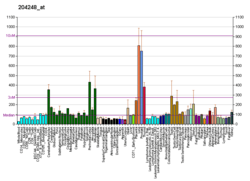GNA11
Guanine nucleotide-binding protein subunit alpha-11 is a protein that in humans is encoded by the GNA11 gene.[5][6] Together with GNAQ (its paralogue), it functions as a Gq alpha subunit.[7]
See also
References
- 1 2 3 GRCh38: Ensembl release 89: ENSG00000088256 - Ensembl, May 2017
- 1 2 3 GRCm38: Ensembl release 89: ENSMUSG00000034781 - Ensembl, May 2017
- ↑ "Human PubMed Reference:".
- ↑ "Mouse PubMed Reference:".
- ↑ Wilkie TM, Gilbert DJ, Olsen AS, Chen XN, Amatruda TT, Korenberg JR, Trask BJ, de Jong P, Reed RR, Simon MI, et al. (Jun 1993). "Evolution of the mammalian G protein alpha subunit multigene family". Nat Genet. 1 (2): 85–91. doi:10.1038/ng0592-85. PMID 1302014.
- ↑ "Entrez Gene: GNA11 guanine nucleotide binding protein (G protein), alpha 11 (Gq class)".
- ↑ 139313 GUANINE NUCLEOTIDE-BINDING PROTEIN, ALPHA-11; GNA11 at OMIM. Retrieved January 1, 2015.
Further reading
- Raymond JR, Mukhin YV, Gelasco A, et al. (2002). "Multiplicity of mechanisms of serotonin receptor signal transduction". Pharmacol. Ther. 92 (2–3): 179–212. doi:10.1016/S0163-7258(01)00169-3. PMID 11916537.
- Jiang M, Pandey S, Tran VT, Fong HK (1991). "Guanine nucleotide-binding regulatory proteins in retinal pigment epithelial cells". Proc. Natl. Acad. Sci. U.S.A. 88 (9): 3907–11. doi:10.1073/pnas.88.9.3907. PMC 51562. PMID 1902575.
- Thomas CP, Dunn MJ, Mattera R (1996). "Ca2+ signalling in K562 human erythroleukaemia cells: effect of dimethyl sulphoxide and role of G-proteins in thrombin- and thromboxane A2-activated pathways". Biochem. J. 312 (1): 151–8. PMC 1136238. PMID 7492305.
- Offermanns S, Simon MI (1995). "G alpha 15 and G alpha 16 couple a wide variety of receptors to phospholipase C". J. Biol. Chem. 270 (25): 15175–80. doi:10.1074/jbc.270.25.15175. PMID 7797501.
- Stanners J, Kabouridis PS, McGuire KL, Tsoukas CD (1996). "Interaction between G proteins and tyrosine kinases upon T cell receptor.CD3-mediated signaling". J. Biol. Chem. 270 (51): 30635–42. doi:10.1074/jbc.270.51.30635. PMID 8530500.
- Laugwitz KL, Allgeier A, Offermanns S, et al. (1996). "The human thyrotropin receptor: a heptahelical receptor capable of stimulating members of all four G protein families". Proc. Natl. Acad. Sci. U.S.A. 93 (1): 116–20. doi:10.1073/pnas.93.1.116. PMC 40189. PMID 8552586.
- Launay JM, Birraux G, Bondoux D, et al. (1996). "Ras involvement in signal transduction by the serotonin 5-HT2B receptor". J. Biol. Chem. 271 (6): 3141–7. doi:10.1074/jbc.271.6.3141. PMID 8621713.
- Johnson GJ, Leis LA, Dunlop PC (1996). "Specificity of G alpha q and G alpha 11 gene expression in platelets and erythrocytes. Expressions of cellular differentiation and species differences". Biochem. J. 318 (3): 1023–31. PMC 1217719. PMID 8836152.
- Kinsella BT, O'Mahony DJ, Fitzgerald GA (1997). "The human thromboxane A2 receptor alpha isoform (TP alpha) functionally couples to the G proteins Gq and G11 in vivo and is activated by the isoprostane 8-epi prostaglandin F2 alpha". J. Pharmacol. Exp. Ther. 281 (2): 957–64. PMID 9152406.
- Wise A, Parenti M, Milligan G (1997). "Interaction of the G-protein G11alpha with receptors and phosphoinositidase C: the contribution of G-protein palmitoylation and membrane association". FEBS Lett. 407 (3): 257–60. doi:10.1016/S0014-5793(97)00300-1. PMID 9175863.
- Carrasco MP, Asbóth G, Phaneuf S, López Bernal A (1998). "Activation of the prostaglandin FP receptor in human granulosa cells". J. Reprod. Fertil. 111 (2): 309–17. doi:10.1530/jrf.0.1110309. PMID 9462300.
- Qian A, Wang W, Sanborn BM (1998). "Evidence for the involvement of several intracellular domains in the coupling of oxytocin receptor to G alpha(q/11)". Cell. Signal. 10 (2): 101–5. doi:10.1016/S0898-6568(97)00097-1. PMID 9481484.
- Dulin NO, Sorokin A, Reed E, et al. (1999). "RGS3 inhibits G protein-mediated signaling via translocation to the membrane and binding to Galpha11". Mol. Cell. Biol. 19 (1): 714–23. PMC 83928. PMID 9858594.
- Hayes JS, Lawler OA, Walsh MT, Kinsella BT (1999). "The prostacyclin receptor is isoprenylated. Isoprenylation is required for efficient receptor-effector coupling". J. Biol. Chem. 274 (34): 23707–18. doi:10.1074/jbc.274.34.23707. PMID 10446129.
- Brydon L, Roka F, Petit L, et al. (2000). "Dual signaling of human Mel1a melatonin receptors via G(i2), G(i3), and G(q/11) proteins". Mol. Endocrinol. 13 (12): 2025–38. doi:10.1210/me.13.12.2025. PMID 10598579.
- Corbetta S, Mantovani G, Lania A, et al. (2000). "Calcium-sensing receptor expression and signalling in human parathyroid adenomas and primary hyperplasia". Clin. Endocrinol. 52 (3): 339–48. doi:10.1046/j.1365-2265.2000.00933.x. PMID 10718832.
- Shraga-Levine Z, Sokolovsky M (2000). "Functional coupling of G proteins to endothelin receptors is ligand and receptor subtype specific". Cell. Mol. Neurobiol. 20 (3): 305–17. doi:10.1023/A:1007010125316. PMID 10789830.
- AbdAlla S, Lother H, Abdel-tawab AM, Quitterer U (2001). "The angiotensin II AT2 receptor is an AT1 receptor antagonist". J. Biol. Chem. 276 (43): 39721–6. doi:10.1074/jbc.M105253200. PMID 11507095.
This article is issued from
Wikipedia.
The text is licensed under Creative Commons - Attribution - Sharealike.
Additional terms may apply for the media files.






